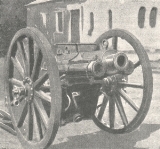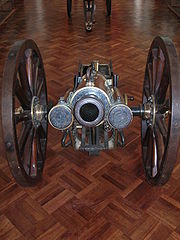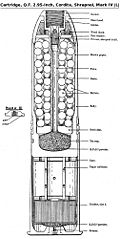
QF 2.95 inch Mountain Gun
Encyclopedia
The QF 2.95 inch mountain gun was the designation given by the British to a Vickers 75mm gun. It was originally produced for the Egyptian Army. It was taken into British service in the late 19th Century to provide the 'movable armament' at some coaling stations. Also known as 'The Millimetre Gun', it was used by the West African Frontier Force in several theatres in Africa during World War I. It was also used by USA and Philippines.
and later the 2.75 inch Mountain Gun
, but it was used from 1901 by the defence forces of some British African colonies as part of the West African Frontier Force (WAFF)
. The officers and most NCOs were British, and the gunners, gun carriers and some NCOs were African. As part of the British Empire these units became part of the British war effort in World War I
.
30 guns were originally supplied to West Africa (Sierra Leone, Gold Coast & Nigeria). Guns involved in the West Africa campaign
of World War I
were Sierra Leone Company RGA (6 guns), Gold Coast Battery WAFF (6 guns), 1st and 2nd Nigerian Battery WAFF (6 guns each).
Guns of the Gold Coast Battery fired the first British Empire artillery rounds of World War I
, in the attack on Khra in Togoland
on 22 August 1914.
The gun was also used in the East Africa campaign
, originally a section of the Gold Coast Battery, and from December 1916 the 1st Nigerian Battery.
(otherwise known as the Philippine Insurrection).
By June 30, 1904 another 120 guns were purchased. Carriages and pack saddles were manufactured at Watertown and Rock Island.
It was also used in World War II
by US and Philippine forces defending against the Japanese invasion.

Combat use
The weapon could be broken down and carried by 4 horses or mules, or in British use in Africa by men.British service
The weapon was not adopted by the British or Indian army, which used the BL 10 pounder Mountain GunBL 10 pounder Mountain Gun
The Ordnance BL 10 pounder mountain gun was developed as a BL successor to the RML 2.5 inch screw gun which was outclassed in the Second Boer War.-History:...
and later the 2.75 inch Mountain Gun
2.75 inch Mountain Gun
The Ordnance BL 2.75 inch Mountain Gun was a screw gun designed for and used by the Indian Mountain Artillery into World War I.-Description:The gun was an improved version of the 1901 BL 10 pounder Mountain Gun....
, but it was used from 1901 by the defence forces of some British African colonies as part of the West African Frontier Force (WAFF)
Royal West African Frontier Force
The West African Frontier Force was a multi-battalion field force, formed by the British Colonial Office in 1900 to garrison the West African colonies of Nigeria, Gold Coast, Sierra Leone and Gambia. The decision to raise this force was taken in 1897 because of concern at French colonial...
. The officers and most NCOs were British, and the gunners, gun carriers and some NCOs were African. As part of the British Empire these units became part of the British war effort in World War I
World War I
World War I , which was predominantly called the World War or the Great War from its occurrence until 1939, and the First World War or World War I thereafter, was a major war centred in Europe that began on 28 July 1914 and lasted until 11 November 1918...
.
30 guns were originally supplied to West Africa (Sierra Leone, Gold Coast & Nigeria). Guns involved in the West Africa campaign
West Africa Campaign (World War I)
The West Africa Campaign of World War I consisted of two small and fairly short military operations to capture the German colonies in West Africa: Togoland and Kamerun.-Overview:...
of World War I
World War I
World War I , which was predominantly called the World War or the Great War from its occurrence until 1939, and the First World War or World War I thereafter, was a major war centred in Europe that began on 28 July 1914 and lasted until 11 November 1918...
were Sierra Leone Company RGA (6 guns), Gold Coast Battery WAFF (6 guns), 1st and 2nd Nigerian Battery WAFF (6 guns each).
Guns of the Gold Coast Battery fired the first British Empire artillery rounds of World War I
World War I
World War I , which was predominantly called the World War or the Great War from its occurrence until 1939, and the First World War or World War I thereafter, was a major war centred in Europe that began on 28 July 1914 and lasted until 11 November 1918...
, in the attack on Khra in Togoland
Togoland
Togoland was a German protectorate in West Africa from 1884 to 1914, encompassing what is now the nation of Togo and most of what is now the Volta Region of Ghana. The colony was established during the period generally known as the "Scramble for Africa"...
on 22 August 1914.
The gun was also used in the East Africa campaign
East African Campaign (World War I)
The East African Campaign was a series of battles and guerrilla actions which started in German East Africa and ultimately affected portions of Mozambique, Northern Rhodesia, British East Africa, Uganda, and the Belgian Congo. The campaign was effectively ended in November 1917...
, originally a section of the Gold Coast Battery, and from December 1916 the 1st Nigerian Battery.
Notable actions
- Corporal Awudo Kano and 5 Nigerian gunners fought a notable action during the British attack near Melong in KamerunKamerunGerman Cameroon was a West African colony of the German Empire from 1884 to 1916 in the region of today's Republic of Cameroon.-History:-1800s:...
, 4 March 1915. Their officer was wounded and the infantry forced to retire, but though isolated they refused to abandon the officer or their guns, and continued firing until relieved.
British Ammunition
The British "Treatise on Ammunition" of 1915 stated that available rounds were Shrapnel (203 bullets), Case shot (330 bullets), Star shell and the Double common shell of 18 lb (exploding charge of 14 oz "P" mixture - gunpowder). |
 |
 |
US service
The US purchased 12 guns in 1899 and used them in the Philippine-American WarPhilippine-American War
The Philippine–American War, also known as the Philippine War of Independence or the Philippine Insurrection , was an armed conflict between a group of Filipino revolutionaries and the United States which arose from the struggle of the First Philippine Republic to gain independence following...
(otherwise known as the Philippine Insurrection).
By June 30, 1904 another 120 guns were purchased. Carriages and pack saddles were manufactured at Watertown and Rock Island.
It was also used in World War II
World War II
World War II, or the Second World War , was a global conflict lasting from 1939 to 1945, involving most of the world's nations—including all of the great powers—eventually forming two opposing military alliances: the Allies and the Axis...
by US and Philippine forces defending against the Japanese invasion.
US Ammunition
The US manual of 1916 stated that the 18 lb (8.2 kg) Double explosive shell was no longer in US use. |
 |
 |
Photographs
- Photo of 2.95 firing in African bush, illustrating recoil and jump : Martin Farndale, History of the Royal Regiment of Artillery : Forgotten Fronts and the Home Base 1914-18
Surviving examples

- A British example is on display at US Army Ordnance Museum, Aberdeen Proving Ground, Maryland, USA
- HM Royal Armouries Fort Nelson, Fareham, Hampshire, England
- At the Military Museum in Bogota, Colombia
External links
- Handbook of the 2.95-inch Mountain Gun Matériel and Pack Outfit. 1912, updated 1916 US Army manual, provided online by University of California and www.archive.org
- 1908 (provisional) Drill Regulations for mountain Artillery US Army Manual provided online by University of California and www.archive.org
- 2.95-Inch Vickers-Maxim Mountain Gun Matériel. in "Handbook of artillery : including mobile, anti-aircraft and trench matériel (1920)" United States. Army. Ordnance Dept May 1920. provided online by University of California and www.archive.org
- side elevation diagram at Palmerston Forts Society
- PAV with 2.95QF Palmerston Forts Society
- photo of a 2.95 inch shell casing at big-ordnance.com

